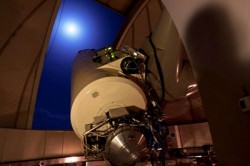[/caption]
It may have looked like a futuristic scene from Star Wars, but ESA’s latest technique for aiding space exploration might shed some “green light” on greenhouse gases. A recent experiment involving the Spanish Canary Islands was conducted by shooting laser beams from a peak on La Palma to Tenerife. The two-week endeavor not only increased the viability of using laser pulses to track satellites, but increased our understanding of Earth’s atmosphere.

While it all sounded good on paper – the proof of a working model is when it is tested. Enter ESA’s optical ground station on Tenerife – a facility built on a peak 2390 meters above sea level and part of a larger astronomical installation called the Observatorio del Teide run by the Instituto de Astrofisica de Canarias (IAC).With equipment placed on two islands, the Tenerife location offered the perfect setting to install receiver hardware grafted to the main telescope. The transmitter was then assigned to a nearly identical peak on La Palma. With nothing but 144 kilometers of ocean between them, the scenario was ideal for experimentation.
Over the course of fourteen days, the team of researchers from the Wegener Center of the University of Graz in Austria and the Universities of York and Manchester in the UK were poised to collect this unique data.

Armin Loscher from ESA’s Future Mission Division added, “It was a challenging experiment to coordinate, but a real pleasure to work with the motivated teams of renowned scientists and young academics.” The experiment was completed within ESA’s Earth Observation Support to Science Element.
Nice shootin’!
Original Story Source: ESA News Release.


